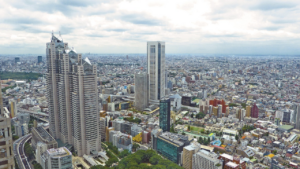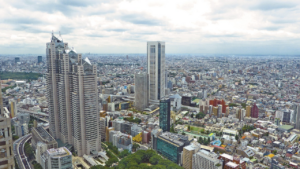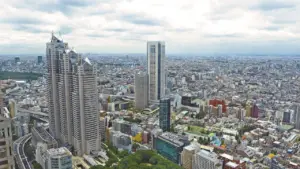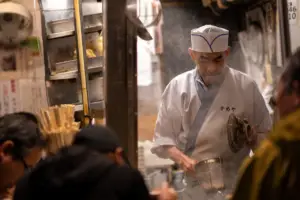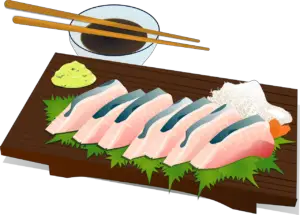Tokyo is a city that needs no introduction when it comes to food. It is a hub of gastronomic delights that draws in foodies from all over the world. From street food vendors to Michelin-starred restaurants, Tokyo has it all. The city’s culinary scene is diverse and constantly evolving, with new trends emerging every year. It is no wonder that Tokyo is considered one of the world’s food capitals.
In this article, we will take a closer look at ten must-try dishes in Tokyo that every foodie should have on their radar. From classic dishes like ramen and sushi to lesser-known delicacies like okonomiyaki and takoyaki, we’ll explore the flavors and textures that make Tokyo’s cuisine so unique.
Whether you’re a seasoned foodie or a curious traveler, this guide will introduce you to some of the best and most delicious dishes that Tokyo has to offer. So, let’s dive in and discover the culinary wonders of Tokyo!
Key Takeaways
- Tokyo is considered one of the world’s food capitals, offering a diverse and constantly evolving culinary scene that draws in foodies from all over the world.
- Must-try dishes in Tokyo include ramen, sushi, okonomiyaki, takoyaki, tempura, yakitori, and tonkatsu, which can be found in many restaurants and food stalls across the city.
- Tokyo is also famous for its matcha desserts, which range from traditional Japanese sweets to modern Western-style desserts, and offer a unique and flavorful experience for those with a sweet tooth.
- Japanese cuisine places a strong emphasis on fresh and seasonal ingredients, and Tokyo’s food culture ranges from traditional Japanese dishes to international cuisine, with many Michelin-starred restaurants and food festivals to explore.
Ramen
Ramen, a staple in Japanese cuisine, is a savory noodle soup dish that elicits a sense of comfort and warmth, featuring a variety of toppings and broth flavors. Its origin can be traced back to China, but the dish has become a quintessential part of Japan’s culinary landscape.
Ramen shops can be found throughout Tokyo, offering different takes on the classic dish. One of the most popular variations is the tonkotsu ramen, made with a rich and creamy broth derived from boiling pork bones for hours. The broth is then seasoned with soy sauce or miso paste, resulting in a hearty and flavorful soup.
Other popular toppings include slices of cha siu (roasted pork), soft-boiled eggs, and nori (dried seaweed). Whether enjoyed on a cold winter day or after a night out with friends, ramen is a must-try dish for any foodie visiting Tokyo.
Sushi
Sushi is a quintessential Japanese dish that has become a global phenomenon.
In Tokyo, there are countless sushi restaurants that offer a diverse range of sushi styles and tastes.
Exploring the best sushi restaurants in Tokyo and the different types of sushi they offer can be a culinary adventure, while learning about the history and evolution of sushi in Tokyo adds an enriching cultural dimension to the experience.
The Best Sushi Restaurants in Tokyo
Amidst Tokyo’s culinary landscape, there are various sushi restaurants that offer an unrivaled dining experience. One such restaurant is Sushi Saito, which has been awarded three Michelin stars and is considered one of the best sushi restaurants in the world.
Chef Takashi Saito only uses the freshest and highest quality ingredients, and his attention to detail is evident in every piece of sushi he creates. The restaurant only seats 10 people at a time, ensuring a personalized and intimate dining experience.
Another notable sushi restaurant in Tokyo is Sukiyabashi Jiro, which has also been awarded three Michelin stars. Chef Jiro Ono is a sushi legend and has been perfecting his craft for over 75 years.
His restaurant is located in the basement of a Tokyo office building and only seats 10 people at once. The sushi is served in an omakase-style format, meaning the chef selects each piece of sushi for the guest based on their preferences.
The restaurant only serves the freshest fish, and Chef Jiro’s techniques and attention to detail are unparalleled. A meal at Sukiyabashi Jiro is truly a once-in-a-lifetime experience for any sushi lover.
Different Types of Sushi
Japanese cuisine offers a wide variety of sushi, each with its own unique flavor and presentation. Nigiri sushi, which is the most popular type, consists of a slice of raw fish or other seafood placed on top of a small ball of sushi rice.
Maki sushi, on the other hand, is a type of sushi that is rolled in nori seaweed, with the rice and fillings wrapped tightly inside. Temaki sushi, also known as hand-rolled sushi, is a cone-shaped sushi that is made by wrapping nori seaweed around a filling of rice, seafood, and vegetables.
Lastly, sashimi is a type of sushi that consists of thin slices of raw fish or other seafood served without the rice.
Each type of sushi has its own unique flavor and texture, making it a must-try for any foodie visiting Tokyo. Nigiri sushi offers a bite-sized explosion of flavors, while maki sushi provides a more filling and satisfying experience. Temaki sushi is perfect for those who want to try something different, as it can be eaten with just one hand. Sashimi, on the other hand, is ideal for those who prefer a lighter meal or are looking for a healthier option.
Whatever type of sushi you choose to try, you are sure to be impressed by the skill and precision of the sushi chefs in Tokyo, who have dedicated their lives to perfecting this art form.
The History of Sushi in Tokyo
Tokyo’s history is deeply intertwined with the development and evolution of sushi as a culinary art form. The origins of sushi can be traced back to the Edo period in Japan, where it was initially served as a street food.
During this time, the use of vinegar in sushi preparation was introduced, which helped to preserve the fish and give it a unique flavor. As sushi grew in popularity, it became a staple in Japanese cuisine, with different regions developing their own variations.
The history of sushi in Tokyo is a rich and fascinating one. Here are some emotions that the audience may experience while learning about it:
-
Awe: As we delve deeper into the history of sushi, we can’t help but marvel at how this simple street food has evolved into a world-renowned delicacy.
-
Appreciation: The use of vinegar in sushi preparation was a game-changer, and we can’t help but appreciate the innovation and creativity of the people who came up with this idea.
-
Nostalgia: As we think about the origins of sushi, we can’t help but feel nostalgic for the bygone era of the Edo period, and the vibrant street food culture that once existed in Tokyo.
Okonomiyaki
Okonomiyaki is a savory pancake that is a staple in Japanese cuisine. As Tokyo is famous for its food culture, it is no surprise that it boasts some of the best okonomiyaki restaurants in Japan.
This article will explore the history of okonomiyaki in Tokyo and highlight some of the best places to try this delicious dish.
The Best Okonomiyaki Restaurants in Tokyo
With a variety of savory ingredients perfectly combined in a fluffy batter and topped with mayonnaise and bonito flakes, the dish commonly known as ‘Japanese pizza’ is a must-try when exploring Tokyo’s culinary scene. Okonomiyaki is a popular dish that originated in the Kansai region of Japan but has become a staple in Tokyo’s street food scene. The dish is a delicious combination of cabbage, flour, eggs, and a variety of meats, seafood, or vegetables, all cooked on a hotplate.
For foodies looking to try the best Okonomiyaki in Tokyo, there are numerous restaurants across the city that offer this dish. Some of the popular restaurants that are known for their Okonomiyaki include Sometaro in Taito, which has been serving the dish for over 80 years. Another popular restaurant is Kiji, located in the Shibuya district, which has a variety of Okonomiyaki dishes on their menu, including vegetarian options. For those looking for a more modern take on the dish, Okonomiyaki Kiji no yume in Shinjuku is the place to go, with its fusion-style Okonomiyaki dishes that incorporate flavors from around the world. Overall, Okonomiyaki is a must-try dish for anyone looking to experience the unique flavors of Tokyo’s culinary scene, and there are plenty of restaurants across the city that offer this delicious dish.
| Restaurant | Location | Specialty | ||||
|---|---|---|---|---|---|---|
| Sometaro | Taito | Traditional-style Okonomiyaki | ||||
| Kiji | Shibuya | Variety of Okonomiyaki dishes, including vegetarian options | ||||
| Okonomiyaki Kiji no yume | Shinjuku | Fusion-style Okonomiyaki dishes incorporating flavors from around the world | ||||
| Chibo | Various locations | Wide variety of Okonomiyaki dishes, including seafood and meat options | Hiroki | Osaka | Known for their traditional-style Okonomiyaki dishes made with high-quality ingredients |
What is Okonomiyaki?
A popular Japanese dish that has become a staple in many restaurants across Japan is Okonomiyaki, a savory pancake-like dish made from a batter filled with a variety of meats, seafood, and vegetables. The name ‘okonomiyaki’ literally means ‘grilled as you like it,’ and it is a dish that allows for endless customization and personalization.
For those who have never tried Okonomiyaki before, it is a must-try dish when visiting Tokyo. Not only is it delicious and filling, but it is also an interactive dining experience. Watching the chef prepare the dish right in front of you on a hot griddle and then being able to add your own toppings and sauces creates a sense of excitement and anticipation.
It is a dish that brings people together and evokes a feeling of warmth and comfort, making it a perfect meal for a cold winter evening.
The History of Okonomiyaki in Tokyo
The roots of the savory pancake-like dish known as Okonomiyaki can be traced back to the Osaka region of Japan in the mid-20th century. However, it quickly gained popularity in Tokyo and became a staple street food in the city. Okonomiyaki is a versatile dish that can be customized to one’s preferences by adding various ingredients such as meat, seafood, vegetables, and noodles. It is often cooked on a griddle in front of the customer, allowing for a unique and interactive dining experience.
The history of Okonomiyaki in Tokyo is closely tied to the city’s post-World War II redevelopment. As Tokyo’s population grew, so did its food culture, and Okonomiyaki was one of the dishes that became synonymous with the city’s bustling street food scene. Today, Okonomiyaki restaurants can be found all over Tokyo, ranging from traditional hole-in-the-wall establishments to modern, upscale eateries. The dish’s popularity doesn’t seem to be waning anytime soon, as locals and tourists alike continue to flock to Tokyo to try this delicious and dynamic dish.
| Ingredient | Description | Example |
|---|---|---|
| Batter | Made from flour, dashi, and eggs | Flour, dashi, eggs |
| Cabbage | Shredded and mixed into the batter | Shredded green cabbage |
| Meat/Seafood | Chopped and added to the batter | Diced pork belly, shrimp |
| Vegetables | Added to the batter or as a topping | Green onions, bean sprouts, carrots |
| Noodles | Optional ingredient | Yakisoba noodles |
| Sauce | Thick and sweet sauce drizzled on top | Okonomiyaki sauce |
| Mayonnaise | Drizzled on top for added creaminess | Japanese Kewpie mayo |
| Bonito Flakes | Thinly shaved dried fish flakes | Dried shaved bonito flakes |
| Aonori | Dried green seaweed flakes | Dried green seaweed flakes |
Note: Dashi is a type of fish stock commonly used in Japanese cooking.
Takoyaki
Octopus lovers visiting Tokyo should not miss the chance to try takoyaki, a popular street food that has become a staple of Japanese cuisine.
Takoyaki translates to grilled or fried octopus, and it is essentially a small ball of batter filled with diced octopus, tempura scraps, green onion, and pickled ginger. The dish is cooked in a special takoyaki pan, which has small round indentations where the batter is poured. The balls are then flipped with a skewer until they are golden brown and crispy on the outside, but soft and gooey on the inside.
Takoyaki dates back to the 1930s, when it was invented in Osaka. However, it quickly became popular in Tokyo and is now a beloved street food all over Japan. The dish is often enjoyed as a snack or a light meal, and it is commonly found at street vendors, festivals, and food courts.
Takoyaki is usually served hot and fresh, topped with mayonnaise, Japanese barbecue sauce, and bonito flakes, which adds to the dish’s umami flavor. Its unique texture and flavor make it a must-try for any foodie visiting Tokyo.
Tempura
Tempura is a Japanese dish that has gained worldwide popularity owing to its unique preparation and taste. The dish is made by deep-frying a variety of seafood and vegetables in a light batter.
Tokyo is home to some of the best tempura restaurants that offer a wide range of options for foodies.
The history of tempura in Tokyo is equally fascinating, with the dish being introduced in the city during the 16th century.
The Best Tempura Restaurants in Tokyo
Located in the heart of Tokyo, the city’s most renowned restaurants boast a wide array of tantalizing dishes, including expertly crafted tempura dishes that are a must-try for any food lover. From crispy vegetables to succulent seafood, tempura is a Japanese dish that has gained worldwide recognition for its delicate texture and delicious taste.
If you’re looking for the best tempura restaurants in Tokyo, here are some of the top picks that are sure to satisfy your cravings:
-
Tenko: This Michelin-starred restaurant is known for its high-quality ingredients and meticulous attention to detail. Their tempura dishes are made with fresh seafood and vegetables, and the batter is light and crispy, creating the perfect balance of flavors and textures.
-
Tensuke: This cozy restaurant offers a traditional dining experience, with a variety of tempura dishes that are cooked to perfection. The chefs use a special blend of oils and flours to create a unique flavor and texture, and the presentation is always impeccable.
-
Mikawa Zezankyo: This hidden gem is located in a quiet residential area, but it’s definitely worth the trip. The restaurant specializes in Edo-style tempura, which is cooked at a lower temperature to preserve the natural flavors of the ingredients. The result is a delicate and flavorful dish that will leave you wanting more.
What is Tempura?
The Japanese delicacy known as tempura is a dish consisting of seafood or vegetables that are battered and deep-fried to create a crispy and savory outer layer. This dish has its origins in the 16th century, when Portuguese missionaries introduced the technique of deep-frying food to Japan. The Japanese perfected this method and transformed it into a unique culinary tradition that is now known all over the world.
Tempura is typically made by dipping the seafood or vegetables in a light batter made from flour, egg, and cold water, before deep-frying them in hot oil. The result is a dish that is crispy on the outside and tender on the inside. Tempura is best enjoyed hot and fresh, and is often served with a dipping sauce made from soy sauce, dashi, and grated daikon radish. Some of the most popular ingredients for tempura include shrimp, squid, scallops, fish, eggplant, sweet potato, and shiso leaves. The dish is often served as an appetizer or as part of a set meal, and is a must-try for anyone visiting Japan.
| Ingredient | Description | Best Served With |
|---|---|---|
| Shrimp | Sweet, succulent, and juicy | Tentsuyu dipping sauce |
| Squid | Tender and slightly chewy | Lemon wedges |
| Scallops | Sweet and delicate | Ponzu dipping sauce |
| Fish | Light and flaky | Grated daikon radish |
| Vegetables | Crispy and flavorful | Salt and lemon juice |
Overall, tempura is a popular dish in Japan and is a must-try for anyone visiting the country. The combination of crispy fried batter and tender seafood or vegetables is a unique and delicious experience that is sure to leave a lasting impression.
The History of Tempura in Tokyo
Deep-fried cuisine has been a part of Tokyo’s culinary scene for centuries, and the history of tempura in the city is a testament to this tradition.
Tempura, which is a dish of lightly battered and deep-fried seafood and vegetables, has its roots in the Portuguese missionaries who visited Japan in the 16th century. At that time, they introduced a technique of deep-frying fish and vegetables, which was known as ‘peixinhos da horta’or ‘little fish from the garden.’The Japanese adapted this technique and created their own version of the dish, which they called tempura.
Tempura became very popular in Tokyo during the Edo period (1603-1868), when street vendors started selling it to the public. The dish’s popularity grew even more when it became a favorite of the shoguns, who ruled Japan at that time. They would often have tempura as part of their meals, and this helped to elevate the dish’s status.
Today, tempura is still a popular dish in Tokyo, and it can be found in many restaurants and street stalls. It is often served as a side dish or as a main course, and it is enjoyed by locals and tourists alike.
Yakitori
Grilled to perfection, Yakitori is a popular Japanese dish consisting of skewered chicken cooked over charcoal, often seasoned with salt or a sweet soy sauce glaze, providing a savory and satisfying taste that will leave your taste buds longing for more.
The origins of yakitori can be traced back to the 17th century, when street food vendors in Tokyo would grill skewered chicken over charcoal and sell them to passersby.
Today, yakitori has become a staple of Japanese cuisine, with many restaurants specializing in this dish.
To fully enjoy the flavors of yakitori, it is important to understand the different cuts of chicken used in this dish.
The most popular cuts are the thigh meat, which is known for its juicy and succulent flavor, and the breast meat, which is leaner and takes on the flavors of the seasoning more readily.
Another popular cut is the skin, which becomes crispy and charred when grilled over charcoal.
When seasoned with salt or a sweet soy sauce glaze, these cuts of chicken create a harmonious blend of flavors that is unique to yakitori.
Tonkatsu
Moving on from the succulent and savory grilled chicken skewers of Yakitori, another dish that is a must-try in Tokyo is Tonkatsu. This Japanese dish is a breaded and deep-fried pork cutlet that is crispy on the outside and juicy on the inside.
Tonkatsu is typically served with shredded cabbage, rice, miso soup, and a tangy sauce made from Worcestershire sauce, soy sauce, and other seasonings. The dish originated in the late 19th century and has since become a beloved staple in Japanese cuisine. Tonkatsu can be found in many restaurants and food stalls across Tokyo, ranging from casual eateries to high-end establishments. It is a dish that is both comforting and indulgent, perfect for satisfying your cravings and filling you up after a day of exploring the city.
| Must-Try Tonkatsu Restaurants in Tokyo | Location | Price Range | Menu Highlights | Specialty Sauce |
|---|---|---|---|---|
| Maisen | Omotesando, Shibuya | $$$ | Kurobuta Pork Tonkatsu | Original Tonkatsu Sauce |
| Tonki | Meguro | $$ | Buta Shabu Tonkatsu Set | Soy Sauce and Vinegar |
| Bairin | Ginza | $$ | Hirekatsu (Pork Loin Cutlet) | Japanese-style Steak Sauce |
| Katsukura | Shinjuku | $$ | Miso Tonkatsu Set | Soy Sauce and Mustard |
| Tonkatsu Tamafuji | Roppongi | $$ | Kurobuta Pork Loin Tonkatsu | Homemade Tonkatsu Sauce |
Whether you are a fan of deep-fried dishes or simply looking for a new culinary adventure, Tonkatsu is definitely worth trying during your visit to Tokyo. With its crispy texture, tender meat, and flavorful sauce, it is a dish that will leave you feeling satisfied and eager to come back for more. So, head over to one of the recommended restaurants and indulge in this Japanese comfort food!
Matcha Desserts
Matcha, a finely ground powder made from green tea leaves, is a prominent ingredient in many Japanese desserts. Tokyo is famous for its matcha desserts, which range from traditional Japanese sweets to modern Western-style desserts.
In this discussion, we will explore the best matcha desserts in Tokyo, the different types of matcha desserts available, and the history of matcha in Tokyo. This will provide an overview of the role this ingredient has played in Japanese cuisine.
The Best Matcha Desserts in Tokyo
Incorporating traditional Japanese ingredients, Tokyo’s dessert scene offers a range of unique and mouth-watering options for food enthusiasts, including a variety of matcha-infused treats. Matcha, a finely ground green tea powder, has been a staple in Japanese cuisine for centuries and has gained popularity in recent years for its health benefits.
Tokyo’s pastry chefs have creatively incorporated matcha into their desserts, creating a unique and flavorful experience for those with a sweet tooth. Here are three of the best matcha desserts to try in Tokyo:
-
Matcha Parfait – Layers of matcha ice cream, red bean paste, mochi, and cornflakes topped with whipped cream and matcha powder make for a refreshing and satisfying dessert.
-
Matcha Roll Cake – Soft and fluffy sponge cake rolled with a generous amount of matcha cream filling creates a perfect balance of sweetness and bitterness.
-
Matcha Tiramisu – A Japanese twist on the classic Italian dessert, matcha powder is mixed into the mascarpone cream to create a unique and delicious flavor that pairs perfectly with the coffee-soaked ladyfingers.
Different Types of Matcha Desserts
Various types of matcha desserts offer a diverse range of taste and texture, from creamy cheesecakes to crispy matcha-infused waffles. Matcha is a finely ground powder made from green tea leaves, and its distinct flavor pairs well with desserts.
One popular type of matcha dessert is the matcha latte, a creamy drink made with steamed milk and matcha powder. The bitterness of the matcha is balanced by the sweetness of the milk, creating a unique flavor profile.
Another delicious matcha dessert is the matcha parfait, which consists of layers of matcha-flavored ice cream, whipped cream, and crunchy granola. The addition of red bean paste and mochi adds a textural contrast to the smooth and creamy ice cream.
Matcha can also be incorporated into traditional Japanese desserts, such as the wagashi. These bite-sized sweets come in a variety of shapes and flavors, and often feature matcha as a key ingredient.
Overall, the different types of matcha desserts offer a delightful culinary experience that is both unique and satisfying.
The History of Matcha in Tokyo
The rich cultural heritage of Tokyo can be traced back to the Edo period, during which matcha became a popular beverage among the samurai class. Matcha is a finely ground powder made from shade-grown tea leaves, and it has been used in traditional Japanese tea ceremonies for centuries. Its popularity soon spread beyond the tea ceremony, and it became a common ingredient in Japanese cuisine, particularly in the form of desserts.
Today, matcha has become a ubiquitous part of Tokyo’s food culture, with countless cafes and restaurants offering various matcha-infused dishes. Here are three interesting facts about the history of matcha in Tokyo:
-
Matcha was originally brought to Japan by a Buddhist monk in the 12th century, and it was used primarily for medicinal purposes.
-
During the Edo period, matcha became a symbol of social status, and it was served exclusively to the samurai class.
-
Matcha was also used as a form of payment during the Edo period, and it was sometimes given as a gift to show appreciation or respect.
The rich history of matcha in Tokyo has contributed to its popularity as a culinary ingredient, and it continues to inspire chefs and foodies alike. Whether enjoyed in a traditional tea ceremony or incorporated into modern desserts, matcha remains an important symbol of Japanese culture.
Frequently Asked Questions
What are the most popular toppings for ramen?
Ramen is a Japanese dish consisting of Chinese wheat noodles served in a meat or fish-based broth, often flavored with soy sauce or miso, and topped with various ingredients.
The most popular toppings for ramen include sliced pork (chashu), green onions, bamboo shoots, nori (dried seaweed), soft-boiled egg, and bean sprouts. These toppings are usually chosen for their flavor and texture, adding depth and complexity to the dish.
Some ramen variations may also include corn, mushrooms, garlic, or chili oil as additional toppings.
Overall, the toppings for ramen vary depending on personal preferences and regional styles, but the aforementioned ingredients are commonly used and well-loved by ramen enthusiasts.
How is sushi traditionally eaten in Tokyo?
Traditionally, sushi is eaten in Tokyo with chopsticks and a small amount of soy sauce for dipping. It is recommended to dip the fish side of the sushi into the soy sauce, rather than the rice, in order to not overpower the delicate flavors of the fish.
Wasabi, a spicy green paste, is also traditionally served with sushi, but should be used sparingly as it can also overpower the flavors. It is considered polite to eat the sushi in one bite, rather than taking multiple bites, and to not mix wasabi into the soy sauce.
Additionally, it is important to not rub chopsticks together, as this is seen as a sign of disrespect towards the chef who crafted the sushi. Overall, it is important to approach sushi eating in Tokyo with respect for the traditions and artistry that go into making this iconic Japanese dish.
What is the origin of okonomiyaki and how has it evolved over time?
Okonomiyaki is a savory Japanese pancake that originated in the Osaka region of Japan in the early 20th century. Its name translates to ‘grilled as you like it,’ reflecting the dish’s flexibility in terms of ingredients and toppings.
Originally, okonomiyaki was made with simple ingredients like cabbage, flour, and eggs, but over time, it evolved to include a variety of proteins like pork, seafood, and chicken. In Hiroshima, a regional variation called Hiroshimayaki emerged, which features layers of noodles and vegetables.
Okonomiyaki has become a popular street food in Japan and can be found in many restaurants across the country. Its popularity has even spread to other parts of the world, including the United States and Europe, where it is often served in Japanese restaurants.
The dish’s evolution reflects the changing tastes of Japanese cuisine and its ability to adapt to new ingredients and techniques while still maintaining its traditional roots.
What are the different types of takoyaki fillings that are commonly used?
Takoyaki is a popular Japanese snack that consists of small, round balls made of batter and filled with diced octopus, tempura scraps, green onion, and other ingredients.
While traditional takoyaki usually contains diced octopus as the main filling, there are many other types of fillings that are commonly used, such as shrimp, cheese, and various vegetables.
Some takoyaki makers also offer unique fillings, such as spicy cod roe, mochi, and even chocolate.
The different fillings can greatly affect the flavor and texture of the takoyaki, making it a versatile snack that can cater to different tastes.
Can you recommend any vegetarian or seafood options for tempura and yakitori dishes?
When it comes to Japanese cuisine, tempura and yakitori are two popular dishes that are often sought after by food enthusiasts.
For vegetarians, tempura can be made with a variety of vegetables, such as sweet potato, pumpkin, eggplant, and green beans. Seafood options for tempura include shrimp, squid, and scallops.
Yakitori, on the other hand, can be made with vegetable skewers, such as shiitake mushrooms, asparagus, and cherry tomatoes. For seafood options, salmon, tuna, and prawn skewers are often available.
It’s worth noting that some yakitori sauces may contain fish or meat, so it’s best to ask the restaurant beforehand if they have any vegetarian or seafood options available.
Conclusion
In conclusion, Tokyo is a haven for foodies, with its diverse range of dishes that cater to every palate. From the rich and flavorful ramen to the delicate and melt-in-your-mouth sushi, Tokyo offers a unique culinary experience that is unmatched.
The city’s street food scene is also worth exploring, with dishes such as okonomiyaki, takoyaki, and yakitori that are packed with flavor and texture.
Moreover, Tokyo’s love for deep-fried food is evident in its crispy and light tempura and tonkatsu dishes.
Lastly, no foodie’s guide to Tokyo is complete without indulging in its matcha desserts, which are not only delicious but also visually appealing.
Tokyo’s food scene is a testament to the city’s rich culture and history, and a trip to this bustling metropolis would not be complete without sampling its diverse range of dishes.






























